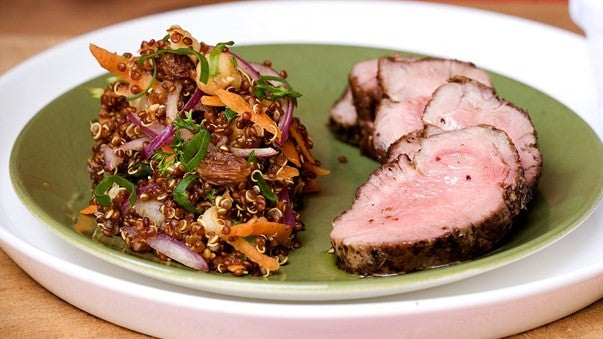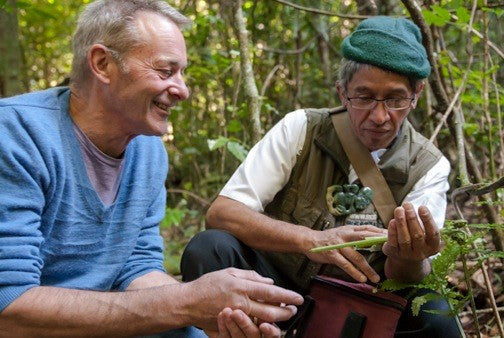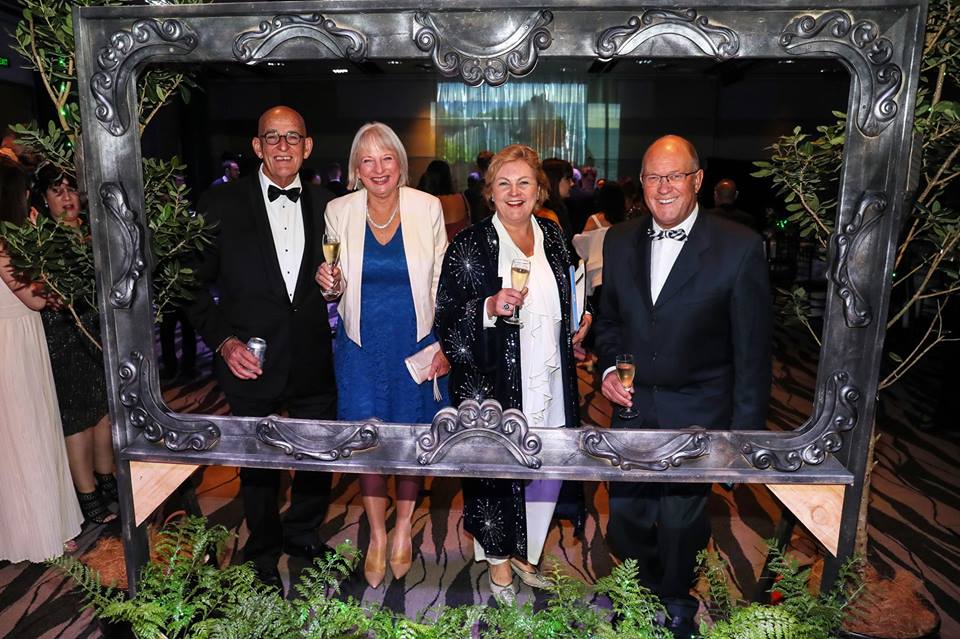News
Octopus carpaccio, capers, shallots and chilli

Renowned chef Sean Connolly shines a light on the unsung hero of Italian cuisine at his restaurant, Gusto at the Grand. His rendition of octopus carpaccio is the palate refresher that everyone needs. Thin slivers of delicately cooked octopus are sprinkled with capers, shallots, fresh chilli and a drizzle of Extra Virgin Olive Oil for the ultimate example of tasteful simplicity.
From Gusto at the Grand
- Claire Be

Horopito rubbed lamb with quinoa raisin carrot salad
Ingredients
Salad
2 tsp Salt
1/2 cup Raisins
2.5 cups Water
1.5 cups Quinoa
1/2 cup Chickpeas, drained and rinsed
1 cup Carrot, grated
1 Red onion, small, finely sliced
2 Tbsp Parsely, finely chopped
1/4 cup Silvered almonds
1 Spring onion, finely chopped
1 Freshly ground black pepper, to season
2 Tbsp Olive oil
1 Lemon, zested and juiced
Lamb
1 Olive oil, to rub
2 Lamb fillets
1 Salt & freshly ground pepper, to season
2 Tbsp Horopito seasoning
Directions
- To make the salad, put the raisins into a small bowl and cover with boiling water. Leave for 15 minutes before draining.
- Put the quinoa into sieve and wash until the water runs clear. Bring the 2 cups of water to a boil, then add 2 tsp of salt. Pour in the quinoa and cook for approximately 15 minutes or until tender. Drain and let cool.
- Add the remaining ingredients to the quinoa, stir and leave while cooking the lamb. This salad is good for up to three days.
- Preheat the oven to 200C. Heat a frying pan. Rub the lamb with olive oil and season well. Sprinkle over the horopito and massage in. Add 1 Tbsp of olive oil to the pan and sear on all sides until golden brown. Finish cooking in the oven for 10 minutes, then remove, cover with tinfoil and let rest for 10 minutes before slicing and serving with the salad.
- Claire Be

Sustainable Foraging for NZ Native Herbs
CHARLES ROYAL is a true forager. This term is rather loosely bandied around the food world at the moment. Its meaning is to hunt and gather from the wild. Before crop cultivation and the farming of animals, foraging was essential for man’s survival. It takes knowledge and skill to know what to gather and use and to do so in a way that allows nature to replenish her larder. Charles has a store house of this information.
After 10 years in the Army Catering Division and more years with Air New Zealand’s flight kitchens, Charles followed his heart to work on the land of his ancestors and spend as much time as possible in his beloved native bush. He sought knowledge from the elders in his area. They shared their stories of food gathering, cooking, preserving and trading from times before European contact.
This led him to develop a range of native seasonings, Kinaki wild herbs, and also incorporate indigenous plants into his cooking. Charles does not deliver “bush tucker”. His food is presented in a sophisticated way that brings together contemporary style with ancient ingredients and techniques. He has begun another Rotorua-based enterprise. Collaborating with other local tour-operators, Charles leads food-based experiences that include sailing to one of Lake Rotoiti’s islands, foraging in the bush, cooking demonstrations, soaking in secret hot pools and of course tasting some uniquely New Zealand food.
The groups are kept small and with warmth and charm Charles reveals what is normally unnoticed on a bush walk, what may be eaten and how to sustainably harvest. One feels in the presence of a forest guardian.
We followed Charles on a mini gathering expedition. He pointed out kawakawa, explaining how to pick the small leaves with holes for food use. This plant has multiple properties and is also widely used in Maori medicine. It has a sharp peppery taste with a tongue numbing effect similar to Sichuan pepper. The larger leaves are used for drying and grinding into a seasoning.
At this time of the year there is abundant wood ear fungus on offer. Leaving the smallest to keep growing, we gathered some to cook. These fungi were exported in vast quantities to China in the late 19th century. Piripiri vine has a growing tip with a natural snap point (like asparagus) and tastes like a cross between a pea and a bean. Refreshingly crisp to eat raw, it can also be steamed. The vine was used to weave cray pots in earlier days. Pikopiko looks a bit like bracken in form. There are many varieties of this fern and it can be used as a vegetable, dried and re-hydrated or as decoration. My very cool little local bar uses the fronds as a swizzle stick in cocktails. A blend of pikopiko, horopito and cayenne pepper form a piripiri seasoning produced under the Kinaki label.
Once back to the side of the lake Charles fired up the barbecue and made us some food. He brought along some hummus and pesto made with his products, a loaf of his soda bread spiralled with pikopiko, and a drink of lemon splash with a leaf of kawakawa added for extra zing. We watched as his professional chef side emerged. Organised and efficient, some main course tastings and desserts were created and savoured beside the shining lake water edged by dark dense hills. Only in Rotorua, Aotearoa
Credits: Grant Allen for the article and © Jason Burgess for the photos.
- Claire Be

SKYCITY Variety of Chefs
Rachael Speedy from NZ Premium Foods attended the SKYCITY Variety of Chefs event that raised over $75,000 for the Variety Club helping kiwi kids in need. Read the full article here
- Claire Be

The Fabulous Baker Boy
Check out this article below about foodies NZ Native Herbs in the restaurant and cafe magazine...
Baker Sam Heaven has collaborated with NZ Premium Foods to bring a distinctly New Zealand flavour to his winning dishes, fusing fresh New Zealand indigenous herbs with classic recipes. Items such as his Horopito croissants and petitgrain sous vide salmon loin with grilled Pikopiko reflect a strong family heritage and innovative style.
Heaven is representative of a new generation of chefs – collaborative as well as innovative. Evidence of this approach is in his teaming up with Rachael Speedy, managing director of NZ Premium Foods. Seedy believes that the rediscovery of indigenous ingredients is helping define exactly what New Zealand cuisine is.
“NZ Premium Foods are supporting a growing trend from foraging to fine dining,” she said. “These new flavours are being added to fish, cheese and even ice-cream”. Of the movement towards using New Zealand indigenous herbs Heaven said, “it’s like getting a new toy to play with but without the worry of foraging and unknown nasties.”
Presently, Heaven is focussed on preparing for the year ahead, developing a training schedule with his World Skills chef coach and psychologically preparing for the Russian competition with a mental skills coach to help optimise his performance.
- Claire Be
